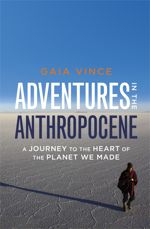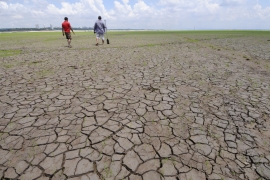
I reported in a November post that it appeared likely that the 2010 Amazon drought was even more severe than the 2005 drought, itself identified as a 1-in-100-year event. Now Simon Lewis of Leeds University and Paulo Brando of Brazil’s Amazon Environmental Research Institute (IPAM) and others have published a paper in Science with rainfall analysis showing that the 2010 drought was indeed more widespread and severe than that of 2005.
The 2005 drought killed billions of trees within the rainforest. On the ground monitoring showed that these forests stopped absorbing CO2 from the atmosphere, and as the dead trees rotted they released CO2 to the atmosphere.
The press release reports that this new research, co-led by Dr Lewis and Brazilian scientist Dr Paulo Brando, used the known relationship between drought intensity in 2005 and tree deaths to estimate the impact of the 2010 drought.
They predict that Amazon forests will not absorb their usual 1.5 billion tonnes of CO2 from the atmosphere in both 2010 and 2011, and that a further 5 billion tonnes of CO2 will be released to the atmosphere over the coming years once the trees that are killed by the new drought rot. For context, the United States emitted 5.4 billion tonnes of CO2 from fossil fuel use in 2009.
They can’t be sure, of course, until they have completed forest measurements on the ground and they describe their results as an initial estimate, one which incidentally does not include any emissions from fires which can be extensive during hot and dry years.
The danger is that this could be a precursor of the Amazon rainforest no longer playing the part it does in regulating atmospheric CO2. Simon Lewis:
“Two unusual and extreme droughts occurring within a decade may largely offset the carbon absorbed by intact Amazon forests during that time. If events like this happen more often, the Amazon rainforest would reach a point where it shifts from being a valuable carbon sink slowing climate change, to a major source of greenhouse gasses that could speed it up.”
Of course it is possible that the two droughts are just an unusual natural variation, but Lewis points out that they are consistent with climate models which project a grim future for Amazonia.
Tropical ecologist Daniel Nepstad is Director of International Programs at IPAM and one of the paper’s authors. He was interviewed a couple of months ago during the Cancún conference.
“It’s about as bad as we’ve seen. I’ve been working in the Amazon for about 25 years now, and I haven’t seen anything like it. We thought we had the worst drought of the century in 2005, and this one is worse.”
The interviewer comments that the drought in 2005 was called a once-in-a-century drought, just five years ago.
“I know. And, there was a drought in 2007 that didn’t even capture any immediate attention, it wasn’t even worth it because drought is really becoming part of the fabric of the Amazon.”
The cause?
“You know, statistically, it’s just very hard to take an individual event like this mega-drought of the Amazon, and say that it is a direct cause of climate change. But, with both this and the 2005 and the 2007 drought, they’re all consistent with the scenario of increasing accumulation of greenhouse gasses in the atmosphere.”
How does the drought affect the rainforest?
“The forest actually makes the rain in the Amazon. By the end of the dry season, a lot of Amazon trees are sucking water from the soil- it could be 60 feet beneath the ground surface. So, they’re going way down deep to get that water, so that they can keep their green lush canopy, even though they’ve been deprived of water for a few months. And, that water going into the atmosphere makes the clouds that make the rain. Similarly, the rain coming down, if it weren’t for that rain, if those dry seasons got longer on a permanent basis, then that forest would cease to be. It would be replaced by grassy vegetations, savannahs, woodlands and scrub that would burn periodically, and that would look very different and have far fewer species.”
What are scientists supposed to think when confronted with possibilities such as those represented by recent Amazon droughts? That it will be interesting to see whether this is the start of a trend which would confirm predictions of the impacts of increasing greenhouse gases? That without further evidence they must be careful not to sound alarmist? In fact Simon Lewis and Daniel Nepstad are properly cautious, acknowledging that as scientists they can’t say with certainty that these droughts are part of human-caused climate change. But they are also very aware of the magnitude of the danger represented by the droughts if they are the result of increased greenhouse gas emissions. A statement by Lewis reported in a Guardian article expresses succinctly why we can’t just wait to see whether further evidence accumulates.
“We can’t just wait and see because there is no going back. We won’t know we have passed the point where the Amazon turns from a sink to a source until afterwards, when it will be too late.”
In other words the possible consequences are so dire that it is reckless to risk them.
“If greenhouse gas emissions contribute to Amazon droughts that in turn cause forests to release carbon, this feedback loop would be extremely concerning. Put more starkly, current emissions pathways risk playing Russian roulette with the world’s largest rainforest.”
That’s a serious warning from a scientist. And the Amazon is not an isolated case. Ove Hoegh-Guldberg, in the presentation Gareth has recently posted, is convinced with good reason that ocean ecosystems are already being seriously impacted under current elevated levels of atmospheric CO2 and that a 450 ppm level will be disastrous for ocean life and consequently for us. The world’s ice is clearly under assault from warming, with the likelihood of sea level rise of fearful consequence to human populations, as scientists like James Hansen now regularly warn. The list is long.
We’re playing Russian roulette with more than the rainforests, and the revolver has more than one chamber loaded. The longer we take to start reducing emissions the more we shorten the odds
Like this:
Like Loading...
 Science journalist Gaia Vince left her desk at Nature and spent two years visiting places around the world, some of them very isolated, where people were grappling with the conditions of what is sometimes described as a new epoch, the Anthropocene. It dates from the industrial revolution and represents a different world from the relatively settled Holocene in which human civilisation was able to develop. Adventures in the Anthropocene tells the story of Vince’s encounters with some remarkable individuals and their communities. It also includes lengthy musings on the technologies the future may employ as humanity faces the challenges of climate change, ocean acidification, population growth, resource depletion and more.
Science journalist Gaia Vince left her desk at Nature and spent two years visiting places around the world, some of them very isolated, where people were grappling with the conditions of what is sometimes described as a new epoch, the Anthropocene. It dates from the industrial revolution and represents a different world from the relatively settled Holocene in which human civilisation was able to develop. Adventures in the Anthropocene tells the story of Vince’s encounters with some remarkable individuals and their communities. It also includes lengthy musings on the technologies the future may employ as humanity faces the challenges of climate change, ocean acidification, population growth, resource depletion and more.


 We know that the vast majority of climate scientists support the explanation of anthropogenic climate change set out by the Intergovernmental Panel of Climate Change. That majority is now quantified in the first study of its kind published yesterday in the Proceedings of the National Academy of Sciences,
We know that the vast majority of climate scientists support the explanation of anthropogenic climate change set out by the Intergovernmental Panel of Climate Change. That majority is now quantified in the first study of its kind published yesterday in the Proceedings of the National Academy of Sciences,